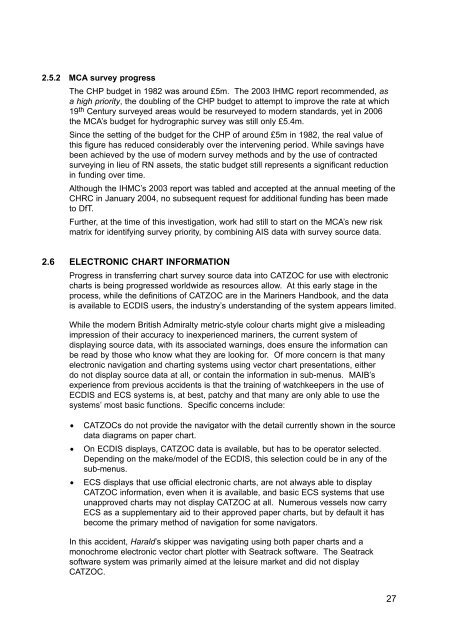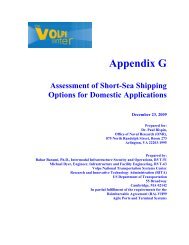Octopus Harald - Marine Accident Investigation Branch
Octopus Harald - Marine Accident Investigation Branch
Octopus Harald - Marine Accident Investigation Branch
Create successful ePaper yourself
Turn your PDF publications into a flip-book with our unique Google optimized e-Paper software.
2.5.2 MCA survey progressThe CHP budget in 1982 was around £5m. The 2003 IHMC report recommended, asa high priority, the doubling of the CHP budget to attempt to improve the rate at which19 th Century surveyed areas would be resurveyed to modern standards, yet in 2006the MCA’s budget for hydrographic survey was still only £5.4m.Since the setting of the budget for the CHP of around £5m in 1982, the real value ofthis figure has reduced considerably over the intervening period. While savings havebeen achieved by the use of modern survey methods and by the use of contractedsurveying in lieu of RN assets, the static budget still represents a significant reductionin funding over time.Although the IHMC’s 2003 report was tabled and accepted at the annual meeting of theCHRC in January 2004, no subsequent request for additional funding has been madeto DfT.Further, at the time of this investigation, work had still to start on the MCA’s new riskmatrix for identifying survey priority, by combining AIS data with survey source data.2.6 ELECTRONIC CHART INFORMATIONProgress in transferring chart survey source data into CATZOC for use with electroniccharts is being progressed worldwide as resources allow. At this early stage in theprocess, while the definitions of CATZOC are in the <strong>Marine</strong>rs Handbook, and the datais available to ECDIS users, the industry’s understanding of the system appears limited.While the modern British Admiralty metric-style colour charts might give a misleadingimpression of their accuracy to inexperienced mariners, the current system ofdisplaying source data, with its associated warnings, does ensure the information canbe read by those who know what they are looking for. Of more concern is that manyelectronic navigation and charting systems using vector chart presentations, eitherdo not display source data at all, or contain the information in sub-menus. MAIB’sexperience from previous accidents is that the training of watchkeepers in the use ofECDIS and ECS systems is, at best, patchy and that many are only able to use thesystems’ most basic functions. Specific concerns include:• CATZOCs do not provide the navigator with the detail currently shown in the sourcedata diagrams on paper chart.• On ECDIS displays, CATZOC data is available, but has to be operator selected.Depending on the make/model of the ECDIS, this selection could be in any of thesub-menus.• ECS displays that use official electronic charts, are not always able to displayCATZOC information, even when it is available, and basic ECS systems that useunapproved charts may not display CATZOC at all. Numerous vessels now carryECS as a supplementary aid to their approved paper charts, but by default it hasbecome the primary method of navigation for some navigators.In this accident, <strong>Harald</strong>’s skipper was navigating using both paper charts and amonochrome electronic vector chart plotter with Seatrack software. The Seatracksoftware system was primarily aimed at the leisure market and did not displayCATZOC.27
















